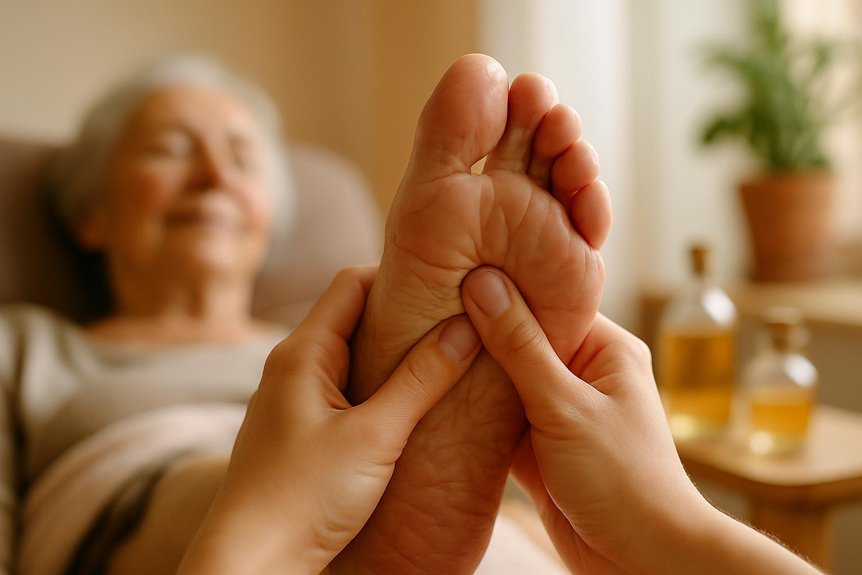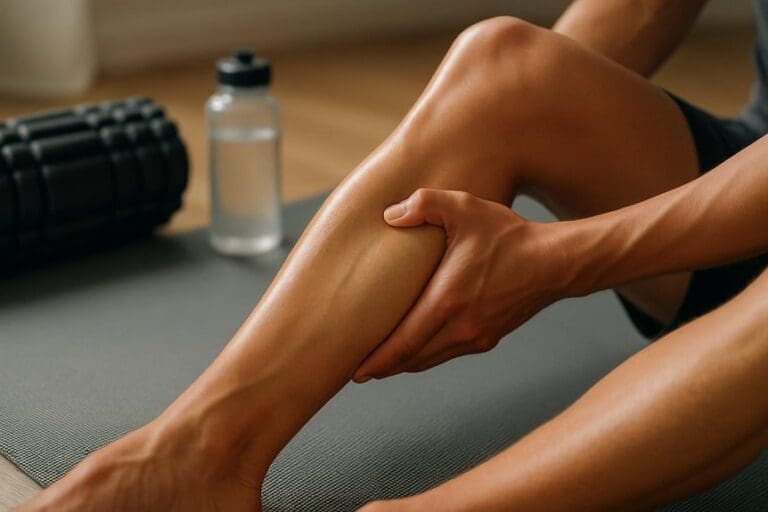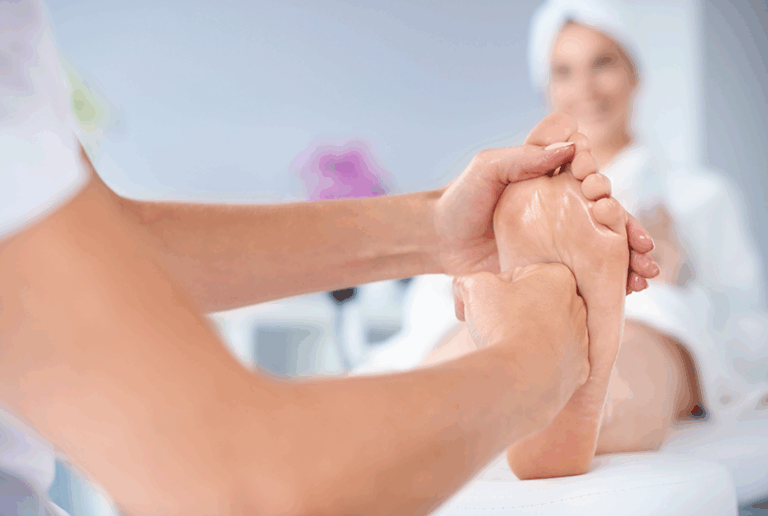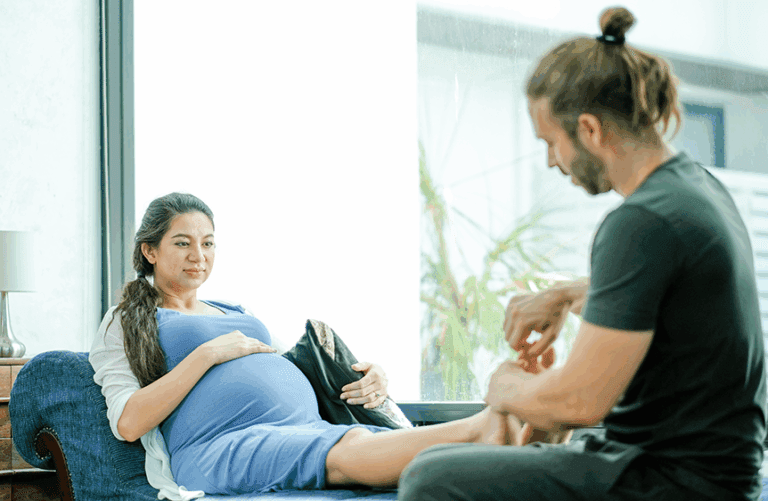It may provide short-term relief for arthritis by modulating nociceptive signaling and autonomic tone via calibrated pressure to foot and hand reflex zones. Mechanisms include activation of cutaneous mechanoreceptors, descending pain inhibition, microcirculatory changes, and reduced muscle guarding. Evidence is limited and heterogeneous, showing modest improvements in pain, stiffness, sleep, and anxiety; it should complement—not replace—medical management. Safety requires avoiding acute flares, inflamed areas, DVT, severe neuropathy, or open wounds. Practical session expectations, techniques, and precautions follow.
Understanding It and How It Works
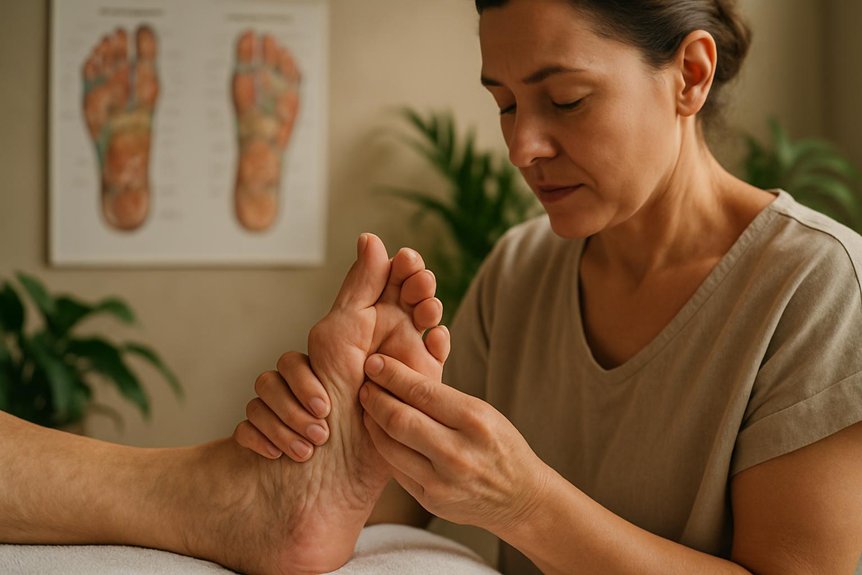
It is a non-invasive manual therapy in which targeted pressure is applied to specific points on the feet, hands, or ears that are mapped to corresponding organ systems via somatotopic “reflex” zones. Its proposed mechanisms are neurophysiologic and circulatory: pressure stimuli activate cutaneous and mechanoreceptor pathways, modulating autonomic tone, nociceptive gating, and regional blood flow.
By reducing sympathetic drive and enhancing parasympathetic activity, reflexology may downshift stress-mediated cytokine signaling, ease muscle guarding, and support microvascular perfusion.
At Spa & Massage clinics across London, therapists apply calibrated thumb-walking and sustained holds to defined reflex maps, prioritising precise, tolerable pressure and clean glide without excessive lubricant. Sessions are sequenced to calm the nervous system first, then address targeted regions, with adjustments guided by tissue response, client feedback, and measurable relaxation cues.
Many people seek out this massage to discover the healing power of this gentle therapy when managing various chronic conditions.
Types of Arthritis and Common Symptoms
How does arthritis differ across diagnoses, and why do symptoms vary? Osteoarthritis reflects progressive cartilage loss and subchondral bone remodeling, often driven by age, prior injury, and metabolic load. Pain worsens with use, morning stiffness is brief, and bony enlargement may appear.
Rheumatoid arthritis is an autoimmune synovitis with pannus formation. It typically involves symmetric small joints, with prolonged morning stiffness, fatigue, and potential nodules.
Psoriatic arthritis blends enthesitis, dactylitis, and axial or peripheral joint disease with skin and nail changes.
Gout features monosodium urate crystal deposition causing abrupt, intensely inflamed flares. Calcium pyrophosphate dihydrate (CPPD) mimics gout with calcium pyrophosphate crystals.
Systemic lupus erythematosus yields non-erosive, migratory arthritis.
At Spa & Massage, therapists note patterns gently—swelling, heat, stiffness, and functional limits—to tailor comfort-focused, joint-respecting sessions.
Potential Benefits of Pressure Point Therapy for Arthritis Relief
Often framed as a complementary modality, targeted foot reflex stimulation may modulate pain perception and autonomic tone relevant to arthritis.
By engaging cutaneous mechanoreceptors, it can activate descending inhibitory pathways, potentially reducing central sensitisation and hyperalgesia.
Gentle, rhythmic pressure may shift sympathovagal balance toward parasympathetic dominance, easing muscle guarding around painful joints and improving sleep quality—both clinically meaningful for osteoarthritis and inflammatory arthritis.
Preliminary trials suggest short-term reductions in perceived pain and stiffness, with possible improvements in functional mobility.
Proposed mechanisms include reduced stress-mediated cortisol flux, subtle enhancement of peripheral microcirculation, and modulation of neuroimmune signaling that influences flare perception, though disease activity is not altered.
At Spa & Massage, therapists apply measured, non-irritative pressure to respect inflamed states and integrate breath-guided pacing to stabilise autonomic responses.
What to Expect in a Massage Session at Spa & Massage
At Spa & Massage, sessions begin with a brief consultation to document symptoms, medication use, and arthritis distribution, establishing contraindications and treatment goals.
Therapists then apply targeted foot and hand massage techniques—graded pressure, mobilisations, and lymphatic-focused strokes—to modulate nociceptive input, reduce protective muscle guarding, and support microcirculatory and autonomic balance.
Aftercare includes hydration, gentle range-of-motion, heat application for stiffness (or cold for flares), and monitoring of symptom change, with therapists providing personalised pacing and self-care guidance.
Warm Welcome and Consultation
Upon arrival, clients are greeted and guided through a brief, structured consultation designed to identify pain patterns, inflammatory load, and functional limitations associated with arthritis.
At Spa & Massage, therapists review diagnosis history, current medications, and recent flares, noting stiffness profiles (morning vs. activity-related), swelling distribution, and sleep quality. They ask about red flags—acute hot joints, systemic symptoms, neuropathic signs—to ensure safety and appropriate adaptations.
Objective screening focuses on tender points in the feet and ankles, edema, skin integrity, and temperature asymmetry, as these may mirror systemic inflammatory activity. Preferences for pressure, positioning, and quiet are documented to protect sensitised tissues and autonomic tone.
This measured intake creates a calm, confidential rapport while aligning session aims with comfort, joint protection, and symptom modulation.
Tailored Massage Techniques
With the assessment complete, the zone therapy plan is calibrated to arthritis phenotype, current flare status, and sensory thresholds.
At Spa & Massage, therapists target reflex zones linked to joint capsules, lymphatic drainage, adrenal modulation, and autonomic balance.
For osteoarthritis, slow, graded compression over foot and hand reflexes supporting cartilage nutrition and pericapsular soft tissue tone is prioritised.
For inflammatory arthritis, micro‑dose pressure, lymphatic sweep patterns, and parasympathetic down‑training predominate to temper nociception and edema.
Techniques shift minute‑to‑minute: pulsed thumb walking for stiff mornings; sustained holds for sympathetically driven pain; feather‑light glides when allodynia is present.
Pressure is titrated using a 0–10 comfort scale, never provoking joint pain.
Positioning supports vulnerable joints; warmed medium is used judiciously to enhance perfusion without triggering flares.
Aftercare and Wellness Tips
Although it is non-invasive, physiological changes continue after a session; thus, Spa & Massage advises structured aftercare to stabilise autonomic tone, optimise microcirculatory effects, and limit post-treatment soreness.
Clients are encouraged to hydrate to support lymphatic clearance of inflammatory metabolites, avoid alcohol for 12–24 hours, and eat lightly to minimise sympathetic activation.
Gentle ankle and toe mobility maintains venous return without provoking joint irritation.
Warmth aids vasodilation; many clients use a brief Epsom-salt foot soak, while ice is reserved for focal arthritic flare with visible swelling.
Sleep hygiene is prioritised to consolidate parasympathetic gains.
Our therapists recommend monitoring pain, stiffness, and morning function; transient heaviness may occur as nociceptive thresholds recalibrate.
Between sessions, low-load walking or hydro-exercise preserves cartilage nutrition and complements Spa & Massage’s zone therapy plan.
Evidence and Safety Considerations
Despite growing interest in this massage for arthritis symptom relief, current evidence remains limited and heterogeneous. Small trials suggest short-term reductions in pain and anxiety, likely via autonomic modulation, reduced sympathetic tone, and altered pain perception through descending inhibitory pathways.
Data specific to osteoarthritis versus rheumatoid arthritis are sparse; outcomes often rely on subjective scales, with inconsistent controls and short follow-up, restricting firm conclusions.
Safety is generally favorable when delivered by trained practitioners. Contraindications include acute inflammatory flares, unhealed fractures, severe peripheral neuropathy, active DVT, unstable cardiovascular disease, and open wounds.
Caution is advised with anticoagulants, severe edema, or diabetic foot changes. At Spa & Massage, therapists screen for red flags, adjust pressure for tender joints, avoid inflamed regions, and integrate care alongside medical management, not as a replacement.
Pressure Point Therapy vs. Massage Therapy for Arthritis
Evidence gaps and safety parameters frame how it should be positioned against massage therapy in arthritis care. It targets distal foot or hand zones to modulate autonomic tone and perceived pain, with limited evidence for reducing central sensitisation.
Massage therapy applies graded mechanical loading to muscles, fascia, and periarticular tissues, improving circulation, reducing myofascial trigger activity, and downregulating nociception.
For osteoarthritis, gentle Swedish or light-to-moderate deep tissue work can ease stiffness by improving soft‑tissue compliance. For inflammatory arthritis, low-pressure techniques minimise synovial irritation.
From Spa & Massage’s clinical perspective in London clinics, therapists individualise intensity, avoid inflamed joints, and monitor post-treatment soreness.
It may be preferable during flares or for touch-sensitive clients; massage often offers broader functional gains between flares.
Blended plans are titrated to symptoms and goals.
At-Home Foot and Hand Techniques Between Sessions
Between sessions, a brief daily routine targeting foot and hand reflex zones can modulate nociceptive signaling and sympathetic tone, supporting joint comfort in arthritis.
Spa & Massage therapists recommend slow, graded pressure (to patient tolerance) over plantar and palmar reflex points, maintaining 5–10 second holds to avoid ischemic pain and post-press hyperalgesia.
Emphasis is placed on neutral wrist/ankle alignment, avoiding inflamed joints, and monitoring for increased swelling or paresthesia, which warrants cessation and clinician review.
Daily Self-Care Pressure Point Routine
A structured daily self-care pressure point routine can modulate nociceptive input and autonomic tone in arthritis by targeting reflex zones associated with joint complexes, microcirculation, and stress regulation.
From Spa & Massage’s clinical perspective, efficacy improves with consistency and clear sequencing.
Morning: warm the hands and feet, then trace the spinal reflex line to prime segmental pathways; follow with systematic thumb-walking across shoulder, hip, and knee reflex maps to influence periarticular mechanotransduction.
Midday: brief solar plexus and diaphragm holds to dampen sympathetic drive, paired with gentle venous return strokes toward the ankle and wrist to support microvascular perfusion.
Evening: apply light effleurage using a neutral, hypoallergenic oil as our therapists recommend, then revisit metacarpophalangeal and metatarsal heads, ending with slow, counted breathing to consolidate parasympathetic settling.
Safe Pressure Techniques
Two core principles underpin safe at-home zone therapy for arthritis: dose-controlled pressure and tissue-aware pacing. Spa & Massage advises using 1–2 kg of force (gentle thumb pressure) for 5–8 seconds per point, then releasing fully to permit capillary refill and neural down‑regulation.
On feet, glide along the medial arch (spine reflex) and circle the plantar heel (pelvic reflex), avoiding direct compression over inflamed joints.
On hands, trace the thenar eminence and web spaces, keeping wrists neutral to protect the synovium.
A slow 1:1 work-to-rest ratio lowers nociceptor sensitisation and limits flare risk. Stop with sharp pain, warmth, or swelling.
Light oil is optional; in our clinics, unscented grapeseed supports controlled glide.
Frequency: 5–10 minutes, up to twice daily, between professional sessions.
How to Prepare and Book With Our Therapists in London
Curiously, ideal outcomes begin before the session: appropriate preparation and precise booking streamline care and reduce symptom flares. Clients are advised to gather clinical details—arthritis subtype, flare frequency, medications, anticoagulants, neuropathy, and recent imaging—so therapists can modulate pressure and avoid exacerbating synovitis or Raynaud-like vasospasm.
Hydration and a light meal reduce post-session vasovagal symptoms. Loose clothing facilitates assessment of foot and ankle biomechanics, relevant to load distribution and nociceptive drive.
Booking at Spa & Massage is simple: select the nearest London clinic—Crouch End, Bayswater, Chiswick, Earl’s Court, Belsize Park, or Richmond—choose Reflexology, note “arthritis management,” and add access needs.
Early-day slots suit inflammatory morning stiffness; late-day suits mechanical pain. Their therapists confirm contraindications, align goals, and provide aftercare to minimize rebound inflammation.
Conclusion
In brief, this massage may complement arthritis care by modulating autonomic tone, reducing perceived pain, and supporting sleep—factors linked to central sensitization and inflammatory load. While not disease-modifying, targeted foot and hand pressure can ease stiffness and fatigue alongside standard therapy. Importantly, up to 30% of osteoarthritis pain is attributed to central mechanisms, underscoring value in stress-reducing adjuncts. Clients at Spa & Massage can expect individualized, low-risk sessions integrated with medical advice, plus simple at-home techniques to sustain benefits between visits.
